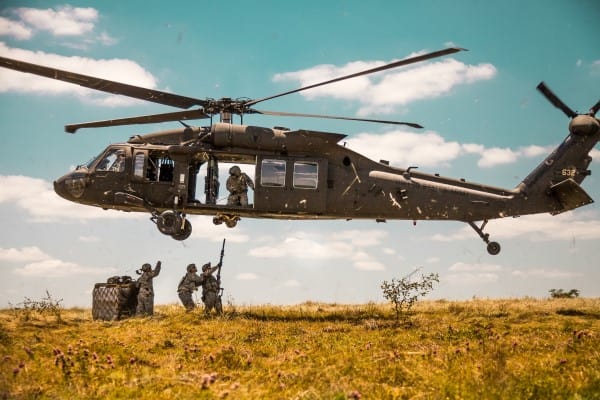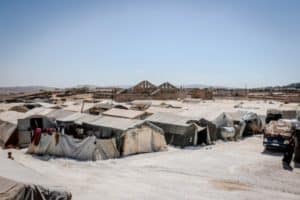This page contains affiliate links. This means if you a follow a link and make a purchase, at no additional cost to you, Humanitarian Careers will receive a commission. Thank you for supporting the site.
A humanitarian intervention is the use of military force against a nation with the stated aim of protecting civilians and ending human rights abuses. By definition, a humanitarian intervention violates a countries sovereignty but the justification for the armed aggression is to respond to atrocities.
Although many people see the 1990s and early 2000s as the peak of humanitarian interventionism, in fact states have used military force to protect civilians throughout history.
We’ve put together a full-list of examples of humanitarian interventions. Some you will know, but we’ll bet you learn of some more obscure ones from history!
British Intervention in Sierra Leone (2000)
In 2000, the UK military intervened in the Sierra Leonean civil war. This is a strong example of a humanitarian intervention as the United Kingdom used its armed forces to protect civilians – both British and Sierra Leonean.
The Sierra Leone Civil War raged from 1991 to 2002 and saw extensive atrocities committed against civilians. In 2000, the rebel group the Revolutionary United Front was close to taking the Sierra Leone capital of Freetown. At first Britain deployed troops to evacuate foreign nationals, but the intervention was later expanded following attacks on British forces and included the protection of Sierra Leone civilians.
The deployment of British forces to Sierra Leone is the prime example of a humanitarian intervention as the sovereignty of the country was breached by a foreign power with the stated intention of protecting civilians and ending human rights abuses.
US and UN Intervention in Somalia (1992)
The US led military operation in Somalia in 1992 is another example of a humanitarian intervention. Following the over-through of Somalian dictator Mohamed Siad Barre and fighting between factional warlords, Somalia faced an extensive humanitarian crisis including famine and human rights abuses.
The United Nations, which had peacekeeping forces in the country, accepted the American offer to deploy troops to protect the distribution of aid.
The US military action in Somalia is an example of a humanitarian intervention as armed forces were used to protect civilians, end atrocities and allow for the delivery of humanitarian assistance.
The US and UN missions in Somalia are also often given as examples of humanitarian interventions that failed. Following deadly attacks on American and UN troops, the humanitarian intervention in Somalia was ended. This resulted in still ongoing violence and recurring famines in Somalia.
US Invasion of Haiti (1994)
Another example of a humanitarian intervention is the US invasion of Haiti. In 1991 a military coup overthrew the elected President of Haiti. Diplomatic efforts were made to return democratic rule to Haiti, but when these failed the United Nations authorised military action.
After the overthrow of the Haitian dictator Raoul Cédras, US forces worked to restore order to the country and deliver humanitarian assistance. By 1995 the American forces had handed over to the United Nations mission in Haiti.
The US invasion of Haiti is an example of a humanitarian intervention because military force was used against a sovereign nation with the aim of assisting the people of that country. The use of armed force was authorised by the United Nations and American troops had a strict mandate to restore democracy and provide aid to the people to Haiti.
India’s Intervention in the Bangladesh Liberation War (1971)
When India gained independence from Britain in 1948, it was divided between India and Pakistan. Pakistan was formed as one country divided between East and West Pakistan. By the 1970’s, East Pakistan – what is today Bangladesh, began an uprising and push for independence from Pakistan.
The Bangladesh war of independence was incredibly violent, with extensive atrocities committed. In 1971, India launched a humanitarian intervention into Bangladesh to assist civilians and help the country gain independence.
The military action taken by India in the Bangladesh liberation war is an often-sighted example of a humanitarian intervention. It is also notable as a key example of a humanitarian intervention lead by a post-colonial state against another developing world country, as opposed to humanitarian interventions conducted by Western nations.
Humanitarian Intervention Online Courses
If you want to learn more about humanitarian interventions throughout history, we highly recommend the online course International Humanitarian Law in Theory and Practice by Leiden University in the Netherlands. International Humanitarian Law is the legal foundation of humanitarian interventions and understanding its basic concepts is key to gaining an overview of past attempts to end crimes against humanity. Click the link to enrol in the course.
Another online short course we highly recommend for those interested in humanitarian interventions is The Changing Global Order, also offered by Leiden University. This course looks at the major shifts in global affairs, including the use of military force against states committing atrocities. Follow the link to the course’s page for more information.
For those wanting to gain a better understand of past humanitarian intervention, we also recommend the online course An International Security Series: Genocide. Many people call for the use of military force to stop countries committing genocide. This online course shows the challenges in doing this and the international security context that surrounds humanitarian interventions. The link if to the course’s page.
Interventions in the Greek War of Independence (1824)
Greece had been ruled by the Ottoman Empire since for several hundred years. When the Greek war of independence began in 1821, initially foreign nations were against intervention. However, as public support in European countries such as Britain and France for the protection of the Christian population of Greece grew, a humanitarian intervention was launched.
The British and French interventions in the war of Greek independence are often given as an example of a humanitarian intervention in the early 19th Century. However, although the protection of Christians was a stated aim of the intervention, it was also launch with the ulterior motive of restricting Russian influence in region.
The military actions taken by Britain and France in the Greek war of independence are a good early example of how humanitarian interventions can be used as a pre-tense for other military and geo-political ambitions.
US Invasion of Iraq (2003)
This is a controversial one! Although it is generally agreed that the American-led invasion of Iraq in 2003 was conducted for geo-political motives, in fact the justification given at the time was that of humanitarian intervention.
The United States used the atrocities committed by the regime of Saddam Hussein against the Iraqi people, as well as the threats it supposedly posed to the rest of the world, as reason to take military action.
As the sovereignty of Iraq was violated by the military of a foreign power under the justification of assisting people, the US invasion of Iraq can be an example of a humanitarian intervention.
The US-led invasion of Iraq is another good example of humanitarian interventions being used as cover for aggressive military action. In fact, the many people sight the 2003 American invasion of Iraq as a reason why humanitarian interventions are now often seen as only pretences.
Iraqi No-Fly Zone (1991)
Following the 2001 Gulf War, a no-fly zone was created over Iraq by Western powers. The northern no-fly zone, over the Kurdish area of Iraq, was created to protect Kurdish forces and civilians from air attacks by the Iraqi air force. The southern no-fly zone was implemented to protect the Shia of Iraq who also rose up against Saddam.
The threat and use of military force by the international community against Iraq with the stated aim of protecting civilians means the 1991 Iraq no-fly zone is an example of a humanitarian intervention.
The no-fly zone in northern Iraq was also created to prevent a repeat of the genocide conducted against the Kurds by Saddam’s forces in the late 1980s. This use of military action to prevent atrocities and crimes against humanity are another reason why the Iraq no-fly zone is an example of a humanitarian intervention.
Libyan Civil War No-Fly Zone (2011)
Following the Arab Spring uprisings, civil war broke out in Libya in 2011. As the forces of dictator Colonial Gaddafi began to get the upper-hand, international public opinion became concerned about wide spread atrocities.
A coalition led by the US, UK and France imposed a no-fly zone over Libya to prevent Gaddafi’s forces continued successes on the battle field. The justification for the implementation of the Libyan no-fly zone was that of a humanitarian intervention.
The use of military force by the Western coalition against the forces of Colonial Gaddafi are an example of a humanitarian intervention. This is because military action was taken against another country with the stated aim of protecting civilians and preventing ethnic cleansing and human rights abuses.
The sovereignty of Libya was violated by the use of military force, which is another reason it is an example of a humanitarian intervention.
Kosovo War (1999)
The Kosovo War was a conflict that occurred as part of the break-up of Yugoslavia. When the ethnic Albanian region of Kosovo began to fight Serbian domination, violence between Serbia and Kosovan forces became widespread. Forces of NATO intervened, declaring a ‘humanitarian war’ with the stated objective to protect Kosovans and help them achieve independence.
The NATO attacks as part of the Kosovo War are often given as an example of a successful humanitarian intervention. Faced with overwhelming fire-power, Serbia withdrew and an independent state of Kosovo was declared. There has mainly been peace since the NATO humanitarian intervention.
1990s saw many examples of humanitarian interventions as Western powers used their forces to try and stop, or prevent, atrocities around the world. The NATO intervention into the Kosovo War is often given as a prime example of humanitarian interventions in this era.
NATO Intervention in Bosnia (1992)
Another example of a humanitarian intervention in this period is the NATO intervention into the Bosnian War. In the conflicts that occurred during the break-up of Yugoslavia, the region of Bosnia saw extensive fighting, and many atrocities committed by Serbian and Bosnian forces.
NATO intervened in the Bosnia War after public outrage at numerous human rights abuses and crimes against humanity. The siege of Sarajevo and the Srebrenica massacre both drove public opinion before and during the intervention.
It’s important to note that the NATO intervention in Bosnia came late in the conflict and it is often given as an example of what can happen if humanitarian interventions are delayed.
The use of armed forced by NATO to end the conflict in Bosnia is often sighted as further example of a successful humanitarian intervention.
Following the intervention by NATO forces Bosnia was declared an independent state and relative piece was achieved.
United Nations Mission in Eastern DRC (2010 onwards)
Violence has plagued the eastern Democratic Republic of Congo (DRC) for many years. Armed groups and militia regularly commit atrocities against civilians. This response by the army of the DRC over the years has been ineffective and they are often accused of committing human rights abuses themselves.
There has been a United Nations mission in the Congo since the 1960s. However, since 2010, the UN peacekeeping mandate was expanded and operations in the east of the country enlarged to counter armed groups and protect civilians.
The mission in the eastern DRC is an important example of the United Nations under-taking a humanitarian intervention. UN peacekeepers in DRC were also given a mandate for offensive military action against armed groups, meaning this is an example of the only time a UN humanitarian intervention took aggressive action.
African Union Mission in Darfur (2004 – 2007)
Darfur is a region in western Sudan. There was widespread international outcry when reports of atrocities and genocide being committed by the Sudanese government in Darfur came out. These calls led for a humanitarian intervention in Darfur by the African Union.
Working closely with the United Nations mission in Sudan, the African Union forces in Darfur were deployed to protect civilians and prevent future atrocities. The African Union mission in Darfur is an example of a humanitarian intervention being carried out by African Union forces.
Like many United Nations missions, the African Union mission in Darfur had a strict mandate and was restricted in what actions it could take. Later African Union humanitarian interventions, for example in Somalia (from 2007) had more aggressive mandates.
There are mixed views on the success of the African Union military action in Darfur, however it is an important example of humanitarian interventionism in Africa.
Coalition Against the Islamic State of Iraq and Syria (2014 onwards)
Islamic State of Iraq and Syria (ISIS) rose to prominence in the violence that followed the 2003 US-led invasion of Iraq, and then grew during the Syrian Civil War from 2011. By 2014, they had captured huge areas in both Iraq and Syria. ISIS committed wide-spread atrocities, including the genocide of Yazidi’s in Sinjar.
A humanitarian intervention was launched by Western countries against ISIS to prevent further attacks on civilians and to stop them capturing more territory.
Unlike the 2003 invasion of Iraq, action by Western states against ISIS are seen as a better example of a humanitarian intervention. This is partly because fighting on the ground was left to local forces that were supported by coalition air-strikes. The humanitarian intervention against ISIS did not result in an occupation of Iraq or Syria and so it is harder to attribute ulterior motives.
French Intervention in the Central African Republic (2013 – 2016)
Violence has plagued the Central African Republic (CAR) since independence. In 2013, fighting increased between rebel factions following the over through of the government and capture of the capital Bangui by rebel forces.
In order to restore the government and prevent further human rights abuses, France launched military action in CAR. The French action in CAR is an example of a humanitarian intervention as the military force was used against a state with the aim of protecting civilians and ending violence.
As well as protecting civilians and helping to reinstate the government, France, along with the United Nations, used their military force to occupy CAR and allow humanitarian aid to be delivered. This is another reason why the French military action in CAR is an example of a humanitarian intervention.
French Intervention in Lebanon (1860)
In the 19th Century, present day Lebanon was part of the Ottoman Empire. In 1860, civil conflict broke out between Druze and Christian communities in the area. The Druze community gained the upper hand and committed several massacres of Christian civilians. The conflict also spiled over into modern day Syria with the destruction of the Christian quarter of Damascus.
France launched military action into the Ottoman Empire after reports of Ottoman troops assisting Druze militia.
The French action in Lebanon and Syria is an example of a humanitarian intervention as military action was taken that violated another states sovereignty with the stated objective to protect civilians.
The use of French forces in 1860 is also an important example of a humanitarian intervention in the 19th Century. In fact, the French expedition into the Ottoman Empire to protect Christians is often given as an example of one of the first humanitarian interventions.
Vietnamese Invasion of Cambodia (1978)
In 1978, shortly after the end of the Vietnam War, Vietnam invaded neighbouring Cambodia. The invasion followed attacks by Cambodian forces of the Khmer Rouge against Vietnamese forces along the border. However, the Khmer Rouge is often sighted as one of the most barbaric regimes in history and the Vietnamese invasion of Cambodia is often given as an example of a humanitarian intervention.
Following the invasion, the Khmer Rouge dictator Pol Pot was removed from power and his regime did not continue to govern Cambodia.
The removal of the Khmer Rouge from government by the Vietnamese ended wide-spread and horrific atrocities across Cambodia, and is another reason why the invasion is often given as an example of a humanitarian intervention.
The Vietnamese invasion of Cambodia is a good example of an act of aggression by a state for military ends that later become a humanitarian intervention.
UN Mission in South Sudan (2011 onwards)
South Sudan gained independence in 2011. There has been a United Nations mission in the country since then. In 2013, increased fighting erupted in South Sudan following an attempted coup. This was followed by extensive inter-ethnic fighting that included atrocities and human rights abuses on all sides.
The UN peacekeeping mission in South Sudan was expanded from 2013 to protect civilians as fighting spread across the country. The important role in protecting civilians and limiting abuses by armed militia is why the UN peacekeeping mission in South Sudan is a good example of a humanitarian intervention.
Like all UN missions, the peacekeeping operation in South Sudan has a strict mandate that limits the extensiveness of its intervention. However, the UN operation in South Sudan is an important example of contemporary humanitarian interventions being undertaken by the United Nations.
If you want to learn more about humanitarianism, explore our list of the top humanitarian online courses here.





